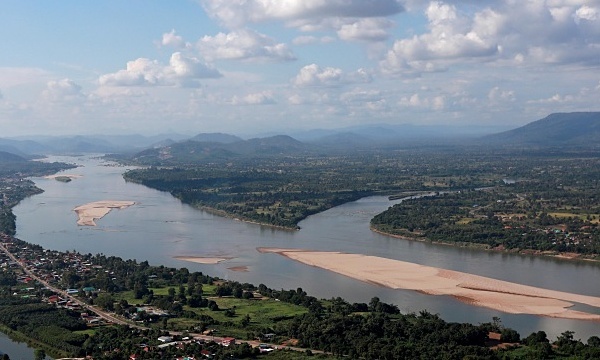Mekong level to drop as China begins power grid maintenance
Mekong level to drop as China begins power grid maintenance
Water levels along the Mekong River are likely to drop by about 1.2 meters between January 5 and 24 due to power grid maintenance in China.
A view of the Mekong river bordering Thailand and Laos is seen from the Thai side in Nong Khai, Thailand, in October 2019. Photo by Reuters.
|
The outflow from the Jinghong hydropower dam in China’s Yunnan province is dropping, leading to dwindling water levels in the Mekong in Thailand, Lao PDR and Cambodia, the Mekong River Commission (MRC) said in a press release on Wednesday.
Its secretariat (MRCS) received a notification from China’s Ministry of Water Resources on January 5, saying the "maintenance of transmission lines of the power grid" will result in water outflow reduction to 1,000 cubic meters per second from January 5 to 24.
The flow would be gradually restored to normal on January 25, it said. But the ministry did not specify the river level before the reduction or the volume to be restored on January 25.
Jinghong is one of 11 hydropower operational dams that China has on the Mekong.
Based on the MRC’s data at Jinghong until January 4, the outflow level started decreasing from 1,410 cu.m on December 31 to 768 cu.m on January 1, representing an almost 50 percent drop.
It rose slightly to 786 cu.m from January 1 to 4.
"As a result, water levels along the Mekong River are likely to drop by about 1.20 meters," the press release said.
In Chiang Saen, the first monitoring station on the Mekong River in Thailand some 300 km downstream from Jinghong, the water level dropped by around two meters between January 2 and 4.
The stretch from Vientiane to Paksane in Laos and Nongkhai in Thailand will experience a drop of 0.22–0.35 meters between January 7 and 11.
In the river’s mainstream between Thailand’s Nakhon Phanom to Laos’s Pakse, the level will fall by 0.03-0.15 meters between January 8 and 11.
In Cambodia, the water levels at Stung Treng, Kratie, Kompong Cham, Phnom Penh, Koh Khel, and Neak Luong had not fallen as of January 5, and are not expected to decline significantly either.
Dr Lam Hung Son, head of the MRC Regional Flood and Drought Management Center, said navigation in the river could be affected, especially close to Jinghong more than the other places.
Some livelihood activities such as riverweed harvesting and fishing could also be affected, and the center would continue to monitor the situation closely, he added.
Under an agreement between China and the MRC, China pledged to notify the MRC and its member countries of "any abnormal rise or fall in water level or discharge, and other information on factors that might lead to sudden flooding."
Downstream countries have witnessed record low levels along the waterway in 2019 and 2020, which have severely harmed livelihoods and raised questions over how mainstream Mekong dams in China and Laos affect the flow of water.
With lack of water an increasing concern, the MRC has been seeking year-round data to help analyze what could be causing the low flow.
Around 60 million people depend on the Mekong for fishing and farming in Thailand, Cambodia, Laos, and Vietnam.






















